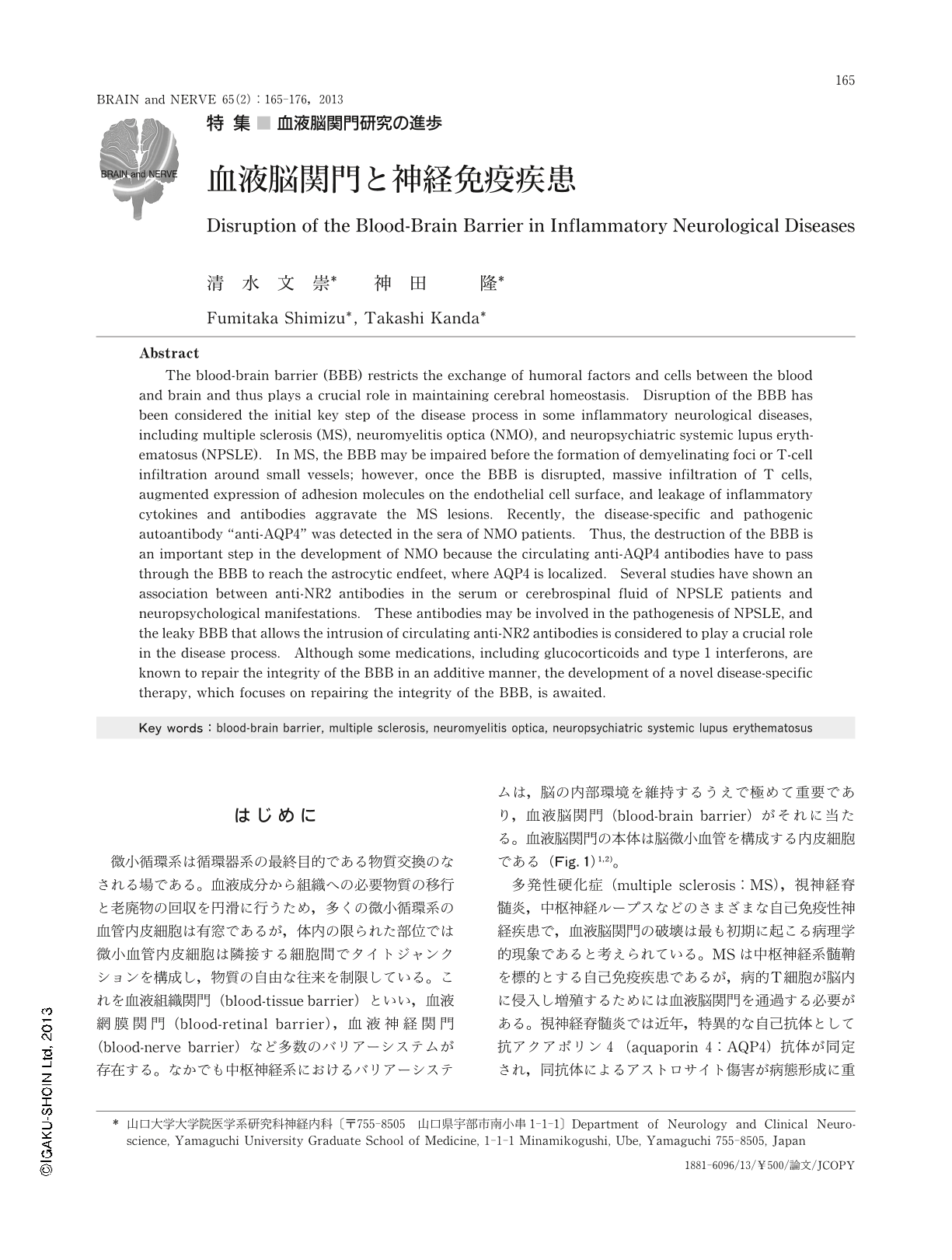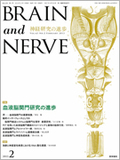Japanese
English
- 有料閲覧
- Abstract 文献概要
- 1ページ目 Look Inside
- 参考文献 Reference
はじめに
微小循環系は循環器系の最終目的である物質交換のなされる場である。血液成分から組織への必要物質の移行と老廃物の回収を円滑に行うため,多くの微小循環系の血管内皮細胞は有窓であるが,体内の限られた部位では微小血管内皮細胞は隣接する細胞間でタイトジャンクションを構成し,物質の自由な往来を制限している。これを血液組織関門(blood-tissue barrier)といい,血液網膜関門(blood-retinal barrier),血液神経関門(blood-nerve barrier)など多数のバリアーシステムが存在する。なかでも中枢神経系におけるバリアーシステムは,脳の内部環境を維持するうえで極めて重要であり,血液脳関門(blood-brain barrier)がそれに当たる。血液脳関門の本体は脳微小血管を構成する内皮細胞である(Fig.1)1,2)。
多発性硬化症(multiple sclerosis:MS),視神経脊髄炎,中枢神経ループスなどのさまざまな自己免疫性神経疾患で,血液脳関門の破壊は最も初期に起こる病理学的現象であると考えられている。MSは中枢神経系髄鞘を標的とする自己免疫疾患であるが,病的T細胞が脳内に侵入し増殖するためには血液脳関門を通過する必要がある。視神経脊髄炎では近年,特異的な自己抗体として抗アクアポリン4(aquaporin 4:AQP4)抗体が同定され,同抗体によるアストロサイト傷害が病態形成に重要なプロセスであると考えられている3)。しかし,同抗体の中枢神経内流入は血液脳関門の存在を抜きには議論できない。また,近年急速に普及したMRIは,自己免疫性神経疾患の早期診断や活動性の評価を可能とし,“血液脳関門の破壊”という現象をわれわれの前に提示してくれるようになった。
自己免疫性神経疾患における血液脳関門破壊を,単に中枢神経内の炎症に引き続いて現れる二次的な現象ではなく,脳内の免疫現象を調節するインターフェースの破綻と捉え,自己免疫性神経疾患において血液脳関門を制御するという観点から有効かつ効果的な治療法を探るのが本稿の目的である。
Abstract
The blood-brain barrier (BBB) restricts the exchange of humoral factors and cells between the blood and brain and thus plays a crucial role in maintaining cerebral homeostasis. Disruption of the BBB has been considered the initial key step of the disease process in some inflammatory neurological diseases, including multiple sclerosis (MS), neuromyelitis optica (NMO), and neuropsychiatric systemic lupus erythematosus (NPSLE). In MS, the BBB may be impaired before the formation of demyelinating foci or T-cell infiltration around small vessels; however, once the BBB is disrupted, massive infiltration of T cells, augmented expression of adhesion molecules on the endothelial cell surface, and leakage of inflammatory cytokines and antibodies aggravate the MS lesions. Recently, the disease-specific and pathogenic autoantibody "anti-AQP4" was detected in the sera of NMO patients. Thus, the destruction of the BBB is an important step in the development of NMO because the circulating anti-AQP4 antibodies have to pass through the BBB to reach the astrocytic endfeet, where AQP4 is localized. Several studies have shown an association between anti-NR2 antibodies in the serum or cerebrospinal fluid of NPSLE patients and neuropsychological manifestations. These antibodies may be involved in the pathogenesis of NPSLE, and the leaky BBB that allows the intrusion of circulating anti-NR2 antibodies is considered to play a crucial role in the disease process. Although some medications, including glucocorticoids and type 1 interferons, are known to repair the integrity of the BBB in an additive manner, the development of a novel disease-specific therapy, which focuses on repairing the integrity of the BBB, is awaited.

Copyright © 2013, Igaku-Shoin Ltd. All rights reserved.


